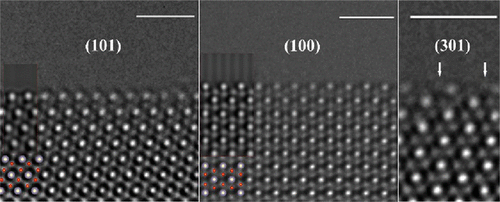当前位置:
X-MOL 学术
›
J. Phys. Chem. C
›
论文详情
Our official English website, www.x-mol.net, welcomes your
feedback! (Note: you will need to create a separate account there.)
Atomic Structure and Properties of SnO2 (100) and (101) Surfaces and (301) Steps in the (100) Surface
The Journal of Physical Chemistry C ( IF 3.3 ) Pub Date : 2020-12-04 , DOI: 10.1021/acs.jpcc.0c10182 Shengsheng Liu 1 , Linhan Liu 1 , Zhiying Cheng 1 , Jing Zhu 1 , Rong Yu 1
The Journal of Physical Chemistry C ( IF 3.3 ) Pub Date : 2020-12-04 , DOI: 10.1021/acs.jpcc.0c10182 Shengsheng Liu 1 , Linhan Liu 1 , Zhiying Cheng 1 , Jing Zhu 1 , Rong Yu 1
Affiliation

|
The atomic and electronic structures of SnO2 surfaces are closely related to their catalysis and gas detection properties. In this study, the atomic structure of SnO2 (100) and (101) surfaces has been directly imaged by aberration-corrected transmission electron microscopy. Combined with density functional theory calculations and image simulations, we show that the (100) and (101) surfaces are terminated with Sn, with large outward relaxations. Bond valence analysis indicates that the surface stability can be attributed to the dual oxidation states (+4 and + 2) that are stable for Sn. For both surfaces, the oxidation state of Sn at the surface is reduced to +2 to compensate the surface polarity. The (301) facets that form steps at the (100) surface are also reduced, with SnO stoichiometry and + 2 oxidation state for Sn.
中文翻译:

SnO 2(100)和(101)表面以及(100)表面中的(301)台阶的原子结构和性质
SnO 2表面的原子和电子结构与其催化和气体检测特性密切相关。在这项研究中,SnO 2的原子结构(100)和(101)表面已通过像差校正的透射电子显微镜直接成像。结合密度泛函理论计算和图像模拟,我们显示(100)和(101)表面以Sn终止,具有较大的向外松弛。键合价分析表明,表面稳定性可归因于对Sn稳定的双重氧化态(+4和+ 2)。对于两个表面,表面处的Sn的氧化态都降低到+2,以补偿表面极性。在SnO的化学计量比和Sn的+ 2氧化态下,在(100)表面形成台阶的(301)面也减少了。
更新日期:2020-12-17
中文翻译:

SnO 2(100)和(101)表面以及(100)表面中的(301)台阶的原子结构和性质
SnO 2表面的原子和电子结构与其催化和气体检测特性密切相关。在这项研究中,SnO 2的原子结构(100)和(101)表面已通过像差校正的透射电子显微镜直接成像。结合密度泛函理论计算和图像模拟,我们显示(100)和(101)表面以Sn终止,具有较大的向外松弛。键合价分析表明,表面稳定性可归因于对Sn稳定的双重氧化态(+4和+ 2)。对于两个表面,表面处的Sn的氧化态都降低到+2,以补偿表面极性。在SnO的化学计量比和Sn的+ 2氧化态下,在(100)表面形成台阶的(301)面也减少了。











































 京公网安备 11010802027423号
京公网安备 11010802027423号